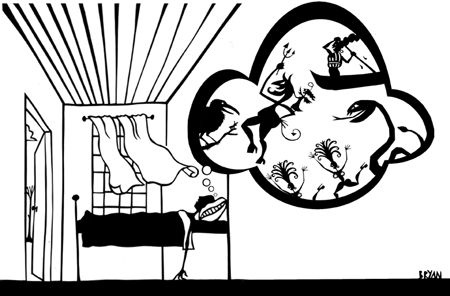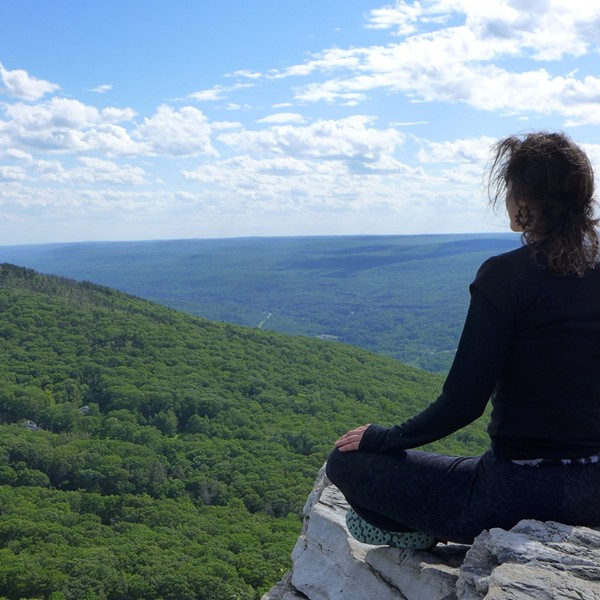We are rather alone in these perspectives. “Most of humanity has seen dreams differently,” Bluestone says. Those alternate views include interpreting the dream world as a place of finding one’s truest self, healing psychological and physical ailments, discovering unique scientific insights, and communicating with and getting help from the spirit world.
This oft-quoted statement, ascribed to Rabbi Hisda from the fourth century, tempts us to look deeper into dreams: “An uninterpreted dream is like an unread letter.” What mountain of mail has been accumulating for those of us who ignore our dreams? How do we start to access them instead?
Dream “work” has actually become popular in the West, too, with a bounty of dream “dictionaries” in bookstores that ascribe meanings to those bizarre images that pop up—the three-legged dog, the boat on a dry riverbed, the slithering snake. But many dream experts agree that searching for meaning this way isn’t the best approach. Symbols can carry drastically different meanings depending on such things as one’s personal history, social context, and religious background.
Doug Grunther is an unquenchable dream enthusiast who recently completed advanced certification in Dream Work Facilitation from the Marin Institute for Projective Dream Work—another step in his dozen years of dream exploration. As host of “The Woodstock Roundtable” on WDST-FM, he upon occasion invites listeners to call in to describe their dreams. He, like his mentors Dr. Jeremy Taylor (founder and director of the Marin Institute) and legendary psychiatrist Montague Ullman, says we each are our own experts. Others can assist the process to some degree; an effective way is for the dreamer to describe what transpired and have a listener tell it back, giving the dreamer a chance to experience it again. The most a listener should do to interpret is, if helpful, say, “If it were my dream, to me it would mean….” Psychiatrists and therapists who impose their own interpretations, or insist a dream can only be understood through professional analysis have, Ullman laments, “killed the dream.”
Grunther’s dream work began with an affinity in the late ’50s and ’60s for Eastern traditions—Buddhism, Taoism, Zen—which opened him to non-Western forms of self-discovery. Then, in the ‘80s, he suffered a period of inexplicable, tenacious allergies that even the best specialists couldn’t alleviate. Grunther eventually realized he might need to “go inside” for an explanation of his malady. During that time he came across Dream Work by Jeremy Taylor.
“It just resonated; it sang to me. I started doing what it recommended—keeping a dream workbook, using the techniques, remembering more dreams.” Within a few months Grunther had a series of dreams that gave him some insights about what might be troubling him. “Then one day, all of a sudden, it popped. It was like the clouds parted, and I realized what was going on. I felt totally elated and exhausted.” Once Grunther understood the dream to signify his mother’s death years earlier, an event he had never dealt with emotionally, he found a therapist who could effectively guide him through that emotional work. Shortly afterward, his allergies disappeared and have never returned.
Taylor, who has since been on Grunther’s radio show many times, has worked over four decades with hundreds of people whose dreams, when decoded, have warned of an impending medical problem, for which they were able to get help before serious repercussions arose. Grunther acknowledges that we can’t rationally explain this, but cites quantum physics as a parallel. “It’s a mystery. We can’t say how it all works. But there are definite techniques we can use to take advantage of dreams.”
Grunther spells out these simple steps to begin dream interpretation. First, get a small notebook that you will devote only to recording your dreams. This will be your dream journal. Put it, as well as a pen that works and a light source, within easy reach of the bed. Then each night before you go to sleep, state your desire to receive a dream. This intention develops dream awareness and recall. (Grunther says it took him five days to start noticing dreams and begin recording them.) Whenever you awaken with the images of a dream, immediately describe it in your journal as completely as possible; record the date. If you can’t devote much time at that moment, jot down a few notes and write more fully later—but soon. You won’t remember details of even the most stunning dreams without notes.
Simply recording dreams may stir insights about yourself and your life. Grunther cites these key principles about dreams as tools of self-knowing: All dreams, including nightmares, come in the service of health and wholeness, not of evil. All dreams have multiple meanings, as do all the images within a dream. Literal interpretations of dreams weaken their power; dreams are not literal stories. All dreams are unique to the dreamer yet carry messages that are universal. And by all means, Grunther says, seek dream books (but recall that dream dictionaries are of limited value), websites, magazines, dream specialists, workshops, and dream groups to enrich your discoveries.
Lucid dreaming is another approach to dreams. Perry Harris, a “dream yogi” in Chester, has been a lucid dreamer for nearly 30 years and has studied extensively; he is completing an update of his book, Wake Up Through Dreaming, which is part autobiography, part teaching tool to help people “open their inner eye” and interact with the images in their dreams.
Harris became interested in dreaming when he took up yoga and read that “when we dream, we think it’s real, and when we’re in waking reality, we think that’s real—both are totally believable.” The Carlos Castaneda books, especially The Art of Dreaming, fueled his curiosity.
Lucid dreaming, Harris explains, “is a great opportunity for self-healing. The idea is to be in the dream with your volition, so you have a piece of the same consciousness as in waking reality. That opens up many doors. You can face your fears. And I believe that illnesses actually start out in your subconscious. If you have a healthy dream reality, you’ll be healthy in waking reality. You can work within the dream world to heal, before problems are manifested in physical reality.”
You can explore lucid dreaming by keeping a journal of your dreams. Then, with practice, stating an intention before you fall asleep to show up in your dream should eventually pay off and allow you to interact with your dream world. (Naps are a good place to start.) Say you’re going through a spell of disturbing dreams where someone is pursuing you for no clear reason; you’re always one step ahead of harm and terrified. Instead of simply awakening with the trauma of this dream, you could face the pursuer and ask what’s going on. It may not actually be a threat but a message relevant to an important choice in life.
You can even resolve issues that might take years to accomplish by other methods, says Harris. Whereas psychiatry takes dreams as clues to issues and then works on them in waking reality—sometimes a very long process—with lucid dreaming, “you go back to the dream world and work on it there. You can get immediate results.” Further, Harris strongly holds that “as we wake up through dreaming, we are becoming more conscious, and creating a better world.”
Consider getting to know your dream world. It’s a resource of vast richness beyond, yes, your wildest dreams.
















